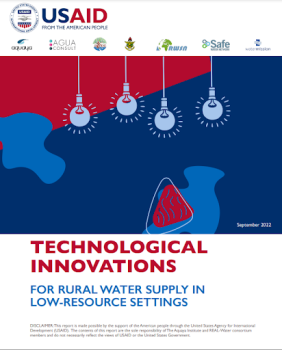CHALLENGE
Rural areas pose special challenges for water supply, as homes may be too few or too dispersed to justify the cost of installing underground pipes from a high-quality water supply source or a centralized drinking water treatment facility. As of 2020, the majority of people lacking even basic water services (i.e., water from a protected source requiring no more than 30 minutes to collect) lived in rural areas.
REPORT OBJECTIVES
This report, produced by USAID’s Rural Evidence and Learning For Water (REAL WATER) activity, provides an overview of water supply technologies that are innovative in either design or application (i.e., not yet commonplace) and promising (i.e., show potential for advantages exceeding the status quo) in rural areas such as small villages and dispersed settlements. It highlights categories of high technology concepts (i.e., advanced electronic devices, materials, and designs) that offer a greater range of options to decision-makers, donors, practitioners, and consumers who manage rural water supplies.
Click to read the Learning Note


